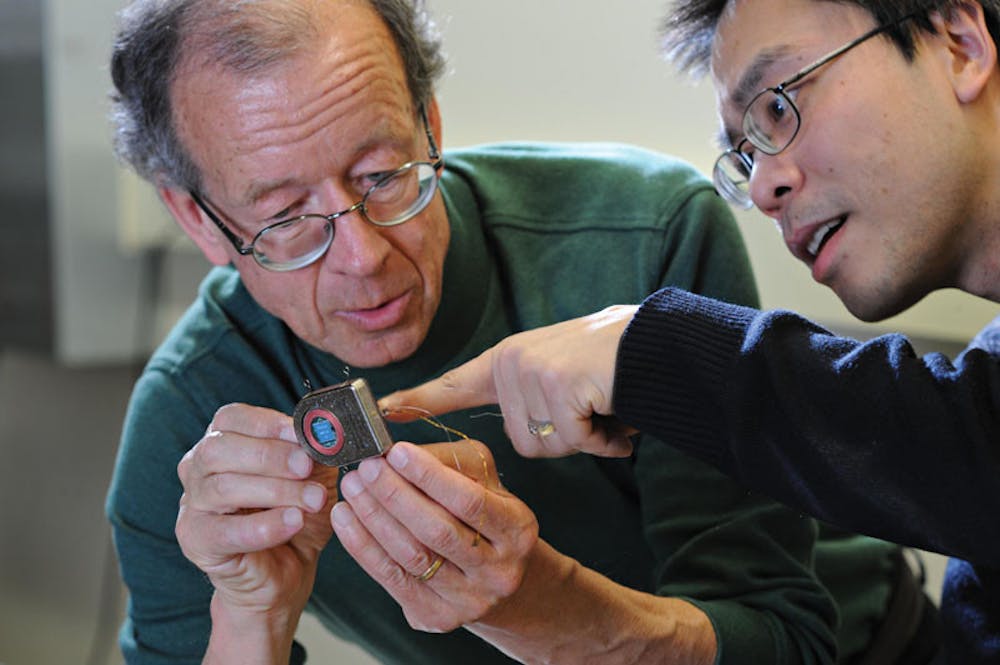University neuroengineers have created a new device that may allow people with paralysis to use their thoughts to control robotic limbs wirelessly. The implantable cerebral mechanism can wirelessly transmit brain signals to a receiver, which can then be interpreted by a computer.
The device was described in a study published in the Journal for Neural Engineering last week.
The mechanism has been successfully functioning in animal subjects for over a year, the authors reported in the study. This is longer than any previous similar device has been tested, making it “a milestone for eventual clinical translation,” said David Borton PhD’12, the study’s lead author. Borton is currently completing his postdoctorate fellowship at the Swiss Federal Institute of Technology.
In this brain-computer interface, a pill-sized chip of electrodes implanted in the cortex can track the activity of up to 100 neurons, according to a University press release. These signals are then passed on to a hermetically sealed titanium “can,” according to the press release.
This receiver contains all the parts of a “brain radio,” according to the release — a lithium ion battery, integrated circuits, wireless radio, infrared transmitters and a copper coil used to recharge the battery wirelessly. The ultra-efficient packing of its components is one of the device’s most distinctive features, Borton said.
“What makes the achievement discussed in this paper so unique is how it integrated many individual innovations into a complete system with potential for neuroscientific gain greater than the sum of its parts,” Borton said in the release.
Professor of Engineering Arto Nurmikko, who oversaw the invention of the device, said the tight sealing was one of the two major challenges the team encountered. The hermetically sealed can is imperative for the device to function properly because “unwanted electricity entering the body” and “biological materials going into the device” could be hazardous, Nurmikko said.
The second challenge was making the device run on “ultra-low power,” Nurmikko said. A reduced need for power would increase “longevity of operation as well as keep heat low,” he added.
Another innovative feature of this technology is its allowance for mobility of the subject, said Juan Aceros, one of the report’s co-authors and a former senior research associate at Brown. Most other similar devices require a wired connection, which can restrict the subject.
“It allows animals to be freely moving,” said Aceros, who is now an assistant professor of electrical engineering at the University of North Florida. “This means that the animals can behave like they would in the wild.”
The wireless setup of the system could reduce the risk of infection because the skin will be able to be fully closed, Aceros added.
After such long-term success in animals, one of the research team’s top priorities is to “push this device for human applications,” said co-author Ming Yin, a Brown postdoctoral fellow and electrical engineer. One of the device’s most important applications could be allowing people suffering from paralysis to control robotic limbs, Yin said.
The device was created in collaboration with the BrainGate research team, a group of scientists and engineers at Brown, Stanford University, Massachusetts General Hospital and Providence’s VA Medical Center. In 2011, BrainGate 2, the second phase of the BrainGate clinical trials, successfully allowed a paralyzed woman to control a robotic arm with her thoughts, The Herald reported last year. While the BrainGate 2 device requires a wire, this wireless interface would improve mobility and practicality, Yin said.
This type of device will prolong observable periods of brain activity because the patient will not have to be wired to the computer, said Professor of Neuroscience John Donoghue PhD’79 P’09 P’12, director of the Brown Institute of Brain Science and co-leader on BrainGate 2.
“It will allow people who would be in the BrainGate study to be using the device all the time,” Donoghue said. “That’s really important.”
The researchers estimated the device could be approved for and functioning in humans within the next decade. In the next few years, the research team hopes to improve the device further by making it smaller and allowing it to transmit more neural data, according to the press release.
One of the most gratifying aspects of the study was the cooperation among researchers from a wide range of disciplines, Yin said. Inventing a device like this required the combined expertise of neuroscientists, computer scientists and biomedical, mechanical and electrical engineers, he said.
“None of this is possible if you don’t have this closely-knit community,” Nurmikko said. “It’s the spirit of Brown.”
—With additional reporting by Kate Nussenbaum

ADVERTISEMENT




